|
The Early Twentieth Century
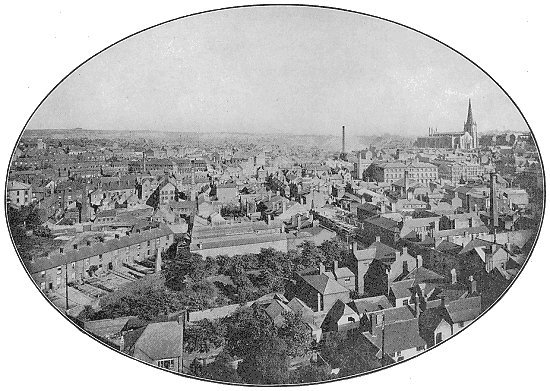
By 1900 the town centre had grown into an affluent, busy and
vibrant shopping area, with shops and businesses of all
kinds, much as it is today. Large numbers of people
travelled to and from the town thanks to the frequent and
cheap tram services that allowed people to travel greater
distances to work or shop. The many industries in the town
offered employment to a large number of people. Around this
time production of leather goods in Walsall reached an all
time high. Around 10,000 people were employed in the local
industry.
On 24th March, 1900 Her Majesty’s Theatre opened in Park
Street. It was Walsall's most successful theatre, seating
over 2,000 people.
During the nineteenth century Walsall's population
dramatically increased. By 1901 it had reached 86,400,
nearly a nine-fold increase over one hundred years.
| |
|
View
some adverts for shops
and businesses in 1902 |
 |
| |
|
|
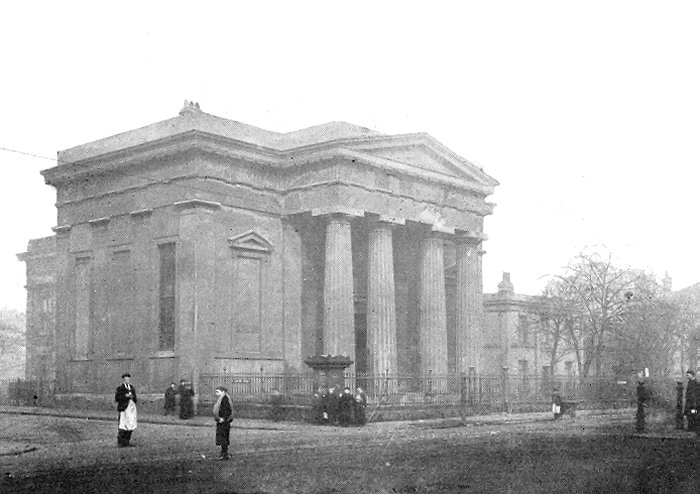
The County Court
before the new town hall was built. |
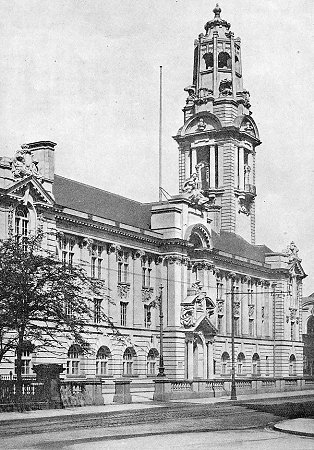 |
|
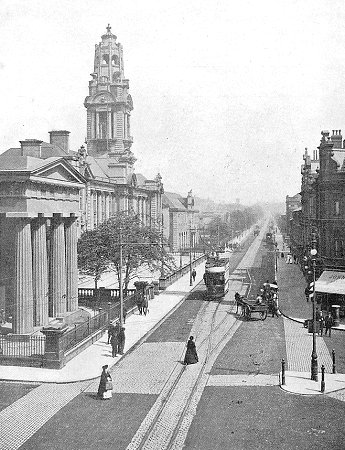 |
|
The new
Council House and Town Hall. |
|
Lichfield
Street. |
|
|
|
|
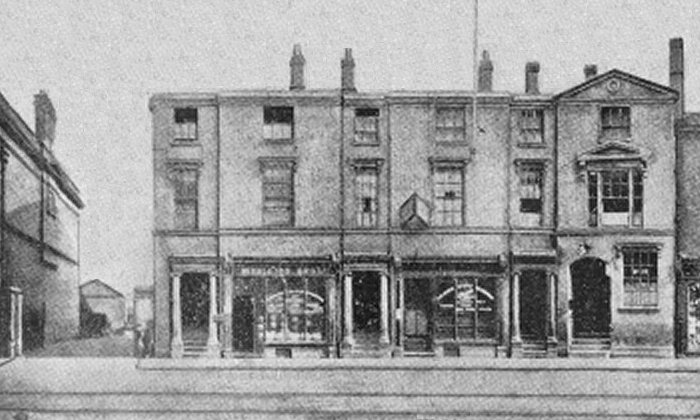
A view of the southern
side of Bridge Street from the early 1900s. On
the left is the entrance to the rear yard behind
the George Hotel on The Bridge. It ran behind
the buildings to the rear of the hotel. The shop
on the left was run by Middleton Brothers. |
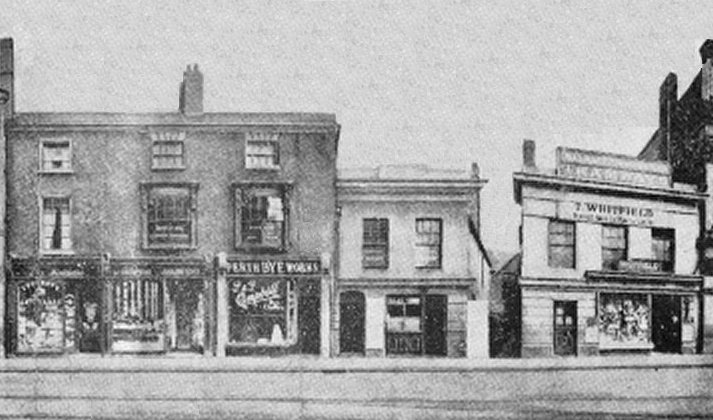
Another view of the
southern side of Bridge Street from around 1900,
to the right of the above photo. The shop at the
end of the terrace on the left is Perth Dye
Works. On the right is T. Whitfield's
tobacconists' shop with Walsall's first
Corporation Tramway Offices above. The buildings
were demolished and replaced with the Walsall
Observer offices. |
By the 1890s, there was a great lack of space and even
overcrowding at the Guildhall in High Street. A
sub-committee was formed to look into the building of a new
town hall, which would be sited at Town End Bank, at the
northern end of Park Street. Mr. H. H. McConnell was
appointed as architect and a grand building was designed to
overlook Park Street. For some years the project was
deferred, but in 1897 the Municipal Building Committee was
formed to find a suitable site for a large building that
could house the council's staff and would include a hall
capable of seating 1,500 people.
On the 18th August,1899, the foundation stone was laid for
Her Majesty's Theatre and so the Town End Bank site was now
unavailable. A site was chosen in Lichfield Street next to
the County Court. The site was occupied by a large house and
Walsall Liberal Club. It was purchased for £6,000 and
adjacent land was acquired for a further £5,000. The
committee inspected 18 town halls, including Birmingham,
which was considered to be a great showpiece for the city.
In 1901, Mr. J. Glenn Gibson was appointed as architect and
Armitage and Hodson of Leeds were appointed as building
contractors.
Work began in the first part of 1902, including the widening
and diverting of the old mill stream. The foundation stone
was laid on Thursday, 29th May, 1902 by Prince Christian of
Schleswig Holstein, followed by a luncheon for over 250
guests. Building work rapidly progressed and the new Council
House and Town Hall opened on the 27th September, 1905. It
had been built
at a cost of £98,000.
It housed the council's many departments including the
Borough Surveyor's Offices; the Gas; Electric; Health;
Weights and Measures; Rate Collectors; and Overseers
departments; the Council Chamber; and the Committee Rooms.
The only department excluded was the police, who remained at
the Guildhall. A large organ was installed in the hall at a
cost of £2,500. Work also included the building of Tower
Street at the end of the site, between Lichfield Street and
Darwall Street.
|
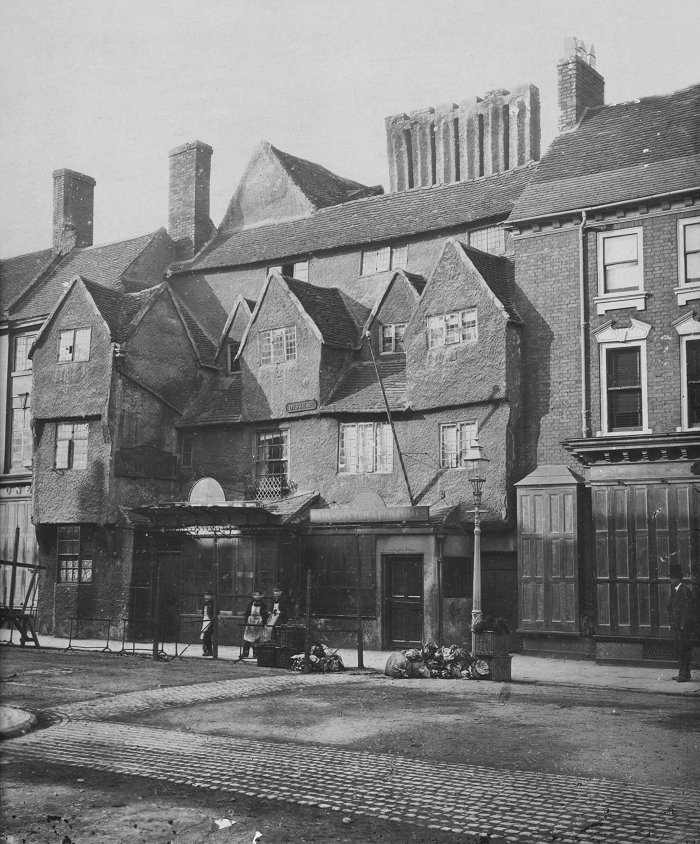
Old shops in Digbeth. |
|
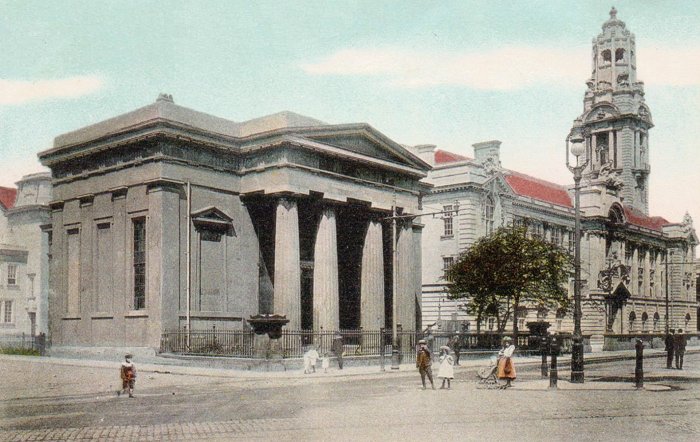
The County Court and the
Town Hall. From an old postcard. |
|

The old Council Chamber in
the Guildhall. |
|
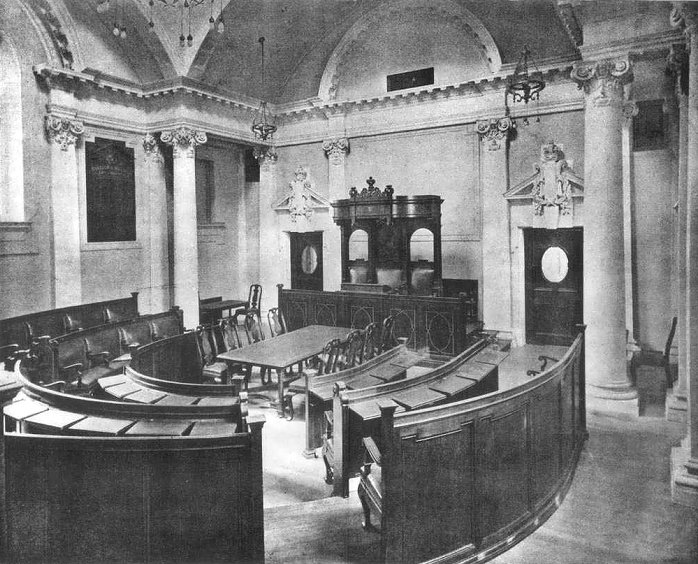
The new Council Chamber in
1905. |
In 1905, Edward Thomas Holden
became the first Freeman of the Borough. He ran E. T. Holden
& Son Limited, in Park Street, the family firm of tanners
and curriers that was founded by his father. He was elected
to Walsall Council in 1860 and served on the council for
sixty two years, becoming mayor three times; 1870 to 71,
1871 to 72 and 1904 to 05. In August 1891 he became Liberal
MP for Walsall after a by-election due to the death of the
MP, Sir Charles Forster. He remained in Parliament until
June 1892. He became a member of Walsall School Board, a
member of the Board of Guardians, a Justice of the Peace for
the borough of Walsall and the county of Staffordshire, and
was knighted in 1907. He died on 13th November, 1926 at the
age of 95.
1906 saw the opening of Walsall's new library in Lichfield
Street. It cost £8,000 and was a gift from Andrew Carnegie,
the Scottish philanthropist.
|
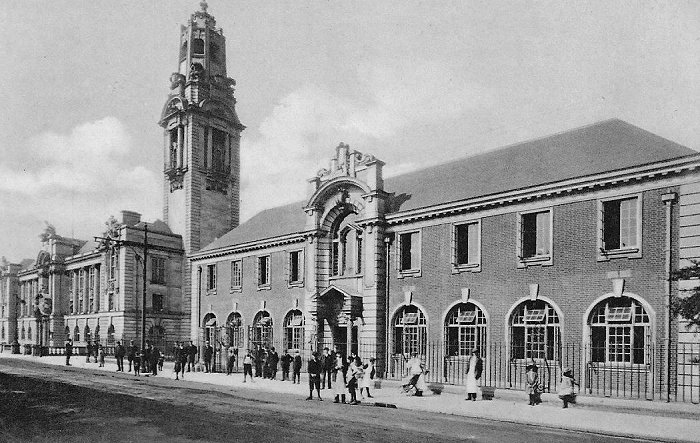
The Town Hall and the
Carnegie Library. From an old postcard. |
The Walsall Golf Club at Gorway was founded on 19th March
1907 on land leased from Lord Bradford. Initially it had six
holes, but a year later was extended to fourteen holes. The
entrance fee was 4 guineas and an annual subscription cost
2 guineas.
1908 saw the opening of the town's first cinema, The
Imperial. It opened in the Imperial Theatre which had been
converted into a cinema. The town's first purpose-built
cinema, the Electric Picture Palace opened on 12th April,
1910 in The Square. It was built by S. Wootton of Bloxwich,
and officially opened by Lady Holden.
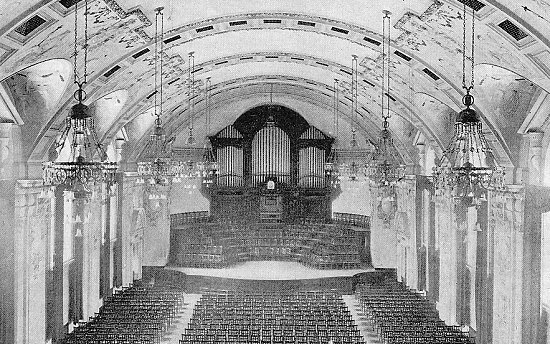
The interior of the Town Hall.

Another view of the Town Hall. Taken
at a local history fair in 2002.
|
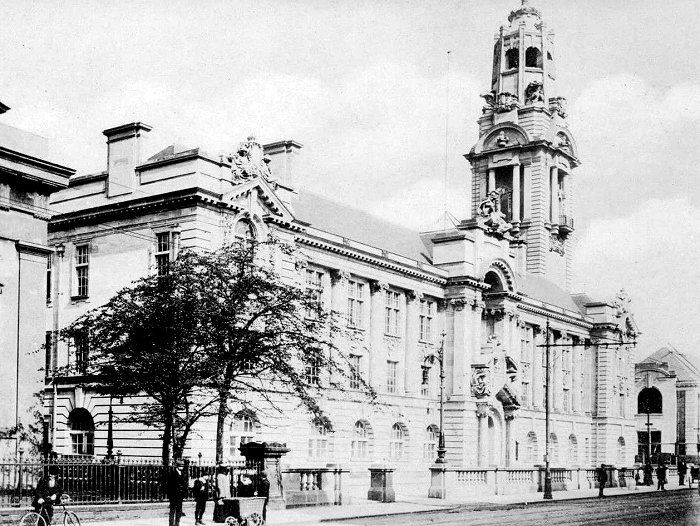
The new Town Hall. From an
old postcard. |
On 24th April 1909 the Walsall Cricket Club opened the
Gorway Cricket Ground on a four and a half acre site costing
£1,500. The inaugural match was between the club XI and a
team representing the senior clubs in the town, including
members of the Walsall Y.M.F. Club, and Shannon's Cricket
Club. Walsall Cricket Club easily won, scoring 150 for four.
Billy Preston was the first to get a half-century on the
ground scoring 77 not out. They dismissed the opponents for
41. The match was followed by an inaugural dinner in the tea
room, attended by the Mayor, and several club 'veterans'.

From the 1934 Walsall Red Book.
In October 1909 a lady health visitor (Hilda Joseph) was
appointed for the town, thanks to pressure from Walsall's
Medical Officer of Health, Dr. Harry Shore. She had to visit
every home containing a young child. Her first report, based
on visits to around six thousand children revealed the
following:
50.9% had bad teeth, 13.5% had dirty heads, 11.3% had
enlarged tonsils, 8.8% had defective hearing, 7.8% had
defective sight, 6.4% had bronchitis, 4.6% had rickets, 3.4%
had ruptures, 2.1% had goitres, and 1% had body vermin.
398 of them were poorly clothed, 773 had poor boots, and 6
had no boots at all.
Dr. Harry Shore's first
report in 1910 commented on how hardship and poverty
affected young mothers, resulting in a high infant mortality
rate, usually from poor housing conditions, lack of
ventilation and overcrowding.
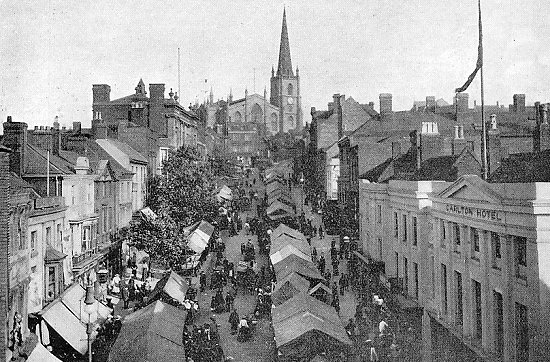
High Street on market day.
The Liberal government passed
a number Acts of Parliament under their Liberal reforms
package which were designed to help the poor. The 1907
Education (Administrative Provisions) Act set up school
medical services that were run by local government. All
children were to receive a medical inspection. The National
Insurance Act 1911 provided for a National Insurance scheme
with provision of medical benefits. Workers were given
access to free treatment for tuberculosis, and the sick were
eligible for treatment by a panel doctor. The unemployed
received a time-limited unemployment benefit, and every mother received
a maternity grant of thirty shillings.
In the years immediately before the First World War the
country suffered from much industrial unrest involving
strikes by railwaymen, miners, engineering workers etc.
Wages were very low and so people were demanding a realistic
minimum wage. One industry greatly affected in Walsall was
tube making. There were strikes at Birchfields and Pleck
involving large numbers of people. Things came to a head on
11th June 1913 when a strike at Walsall's largest tube
manufacturer, the Talbot-Stead Tube Company Limited, in
Green Lane, got out of hand. Twenty men entered the factory
in an attempt to return to work, which greatly angered the
strikers. A crowd of around three thousand gathered outside
the factory which was guarded by two lines of policemen.
They agreed to disperse if the twenty workers would leave
the factory. A riot took place, stones were hurled through
factory windows, and a police refreshment vehicle carrying
food for the police officers on duty, was overwhelmed by the
crowd, and the food carried away.
During the strike the Mayor organised a relief fund which
fed 800 children daily at their schools. The strike
eventually ended in July.
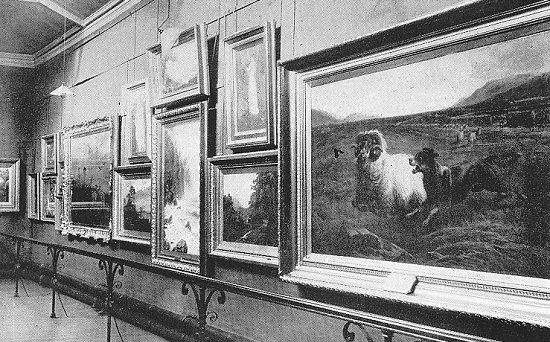
Walsall's lovely old Art Gallery.
A very different event took place on 30th August 1913 when
an aircraft landed in the town for the first time. An
aircraft race had been organised between two pilots,
Bentfield Charles Hucks, and Gustav Hamel for a fine silver
trophy and prize money of five hundred pounds, offered by
the Birmingham Daily Post. The race consisted of several
short flights around a circular route, starting and ending
at the Tally-Ho grounds at Edgbaston.
The first leg was to Redditch recreation ground, followed by
a flight to Green's Field near Allesley Road, Coventry, then
on to Nuneaton, Drayton Manor, and Walsall. The aircraft
landed in Springvale Farm which was near the Birmingham Road
and the modern Park Hall Estate. Gustav Hamel landed in an
adjoining field because he felt that the official one was
too small. When Hucks landed he was surrounded by a waiting
crowd of between 20,000 and 30,000 people. The spectators
included the Mayor, the town councillors and their wives and
friends. After thirty minutes the aviators departed on their
last but one leg to Quinton, before returning to Edgbaston.
Hamel succeeded in beating Hucks by just over twenty
seconds.
Sadly both aviators had short lives. Gustav Hamel
disappeared over the English Channel on 23rd May, 1914 while
returning from Paris in a new 80hp. Morane-Saulnier
monoplane. He was only 24 years old. Bentfield Hucks died on
7th November, 1918 as a result of double pneumonia. He was
34 years old, and is buried in Highgate Cemetery.
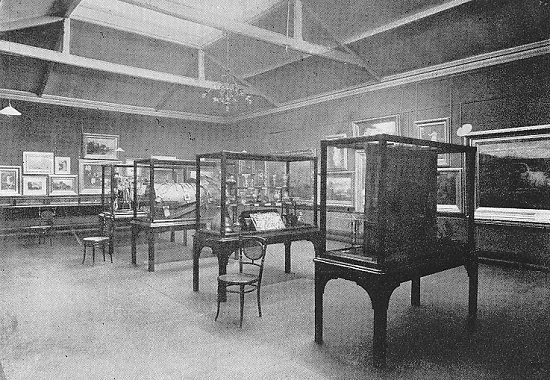
Another view inside Walsall's old Art
Gallery.

Looking down High Street, possibly in
the early 1930s. From a newspaper cutting from an unknown
newspaper.
|
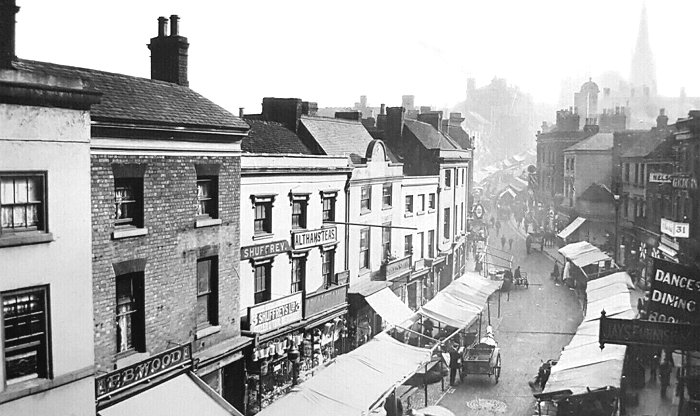
Looking from Digbeth
towards High Street. From an old postcard. |
|
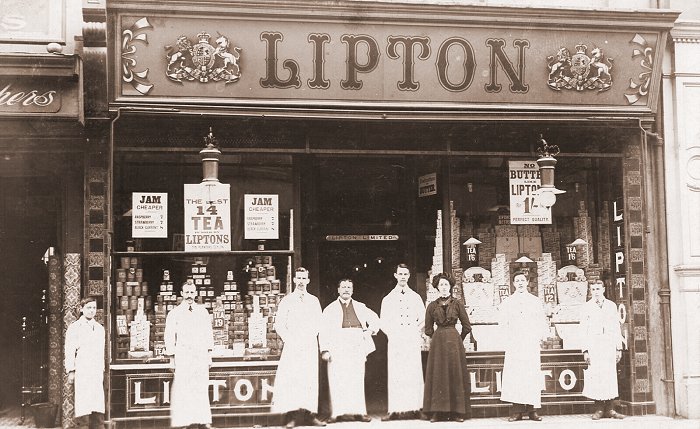
Lipton's grocers shop at
38 Digbeth. From an old postcard. |
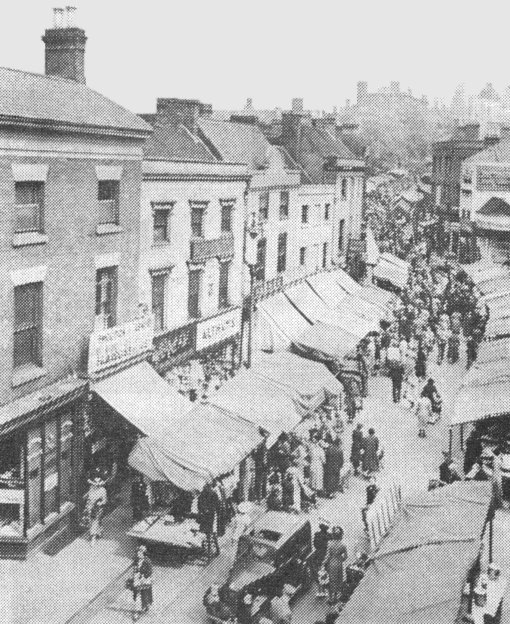
Digbeth in 1939. From a newspaper
cutting.
|
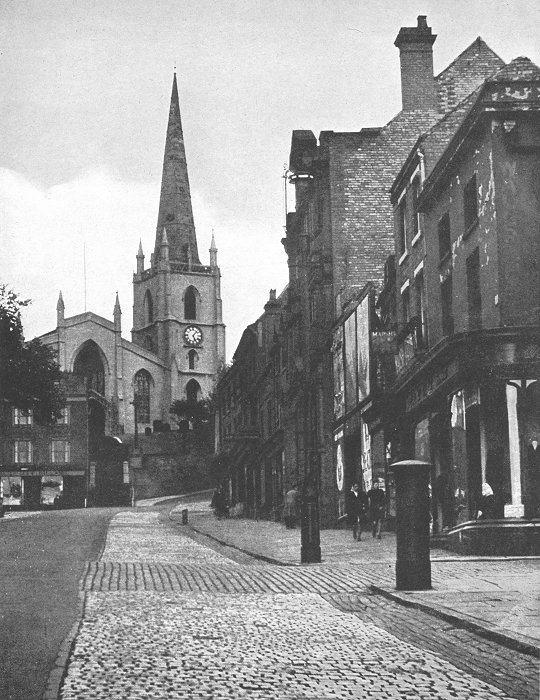
A quiet High Street in the
1940s, possibly on a Sunday. |
|
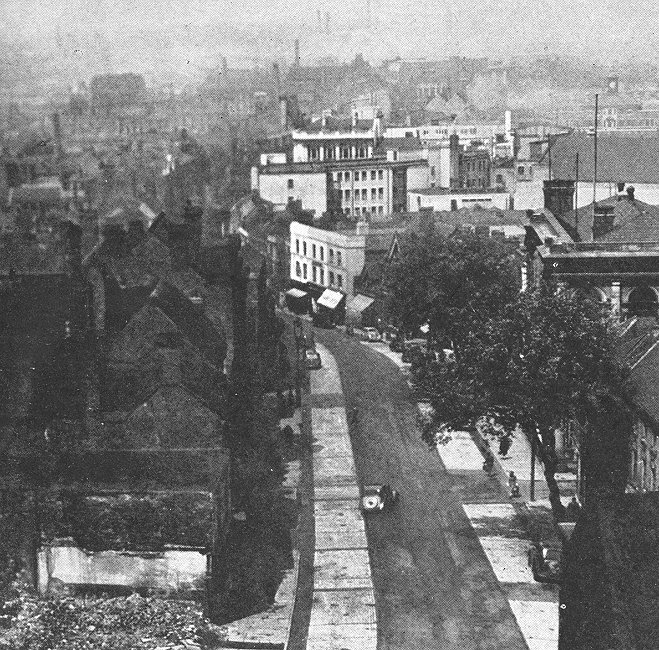
Looking down High Street
in the 1940s. |
|